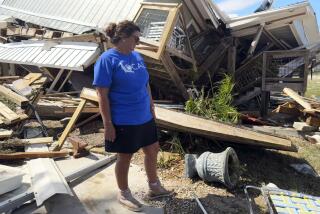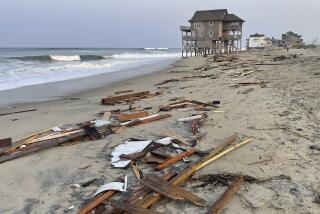Disasters Elsewhere May Be Diverting Visitors to Hawaii : Planning: Hurricanes and other troubles may be helping the islands recover, ironically, from the devastation of Iniki.
If you’ve been contemplating a fall or winter trip to Hawaii, this may be the time to stop contemplating and start booking.
Three years after Hurricane Iniki and an international economic downturn crippled the islands’ tourism industry, the new round of natural disasters in Mexico and the Caribbean apparently is redirecting many travelers toward Hawaii. As a result, Hawaiian flights and hotel rooms are likely to fill up faster and more often than they did in the late months of 1992, 1993 or 1994.
“There’s more demand,” said Bryan Murphy, New York-based spokesman for the Hawaii Visitors Bureau. Since the hurricanes and earthquakes of September and early October, he said, “we’re experiencing a couple of hundred phone calls a day, and that’s 15%-20% more than normal.”
In speaking with island hotels, Murphy said, he’s finding that “they’re all on the plus side as opposed to [the business] they were doing last year at this time.”
At Outrigger Hotels & Resorts, a statewide chain of 29 hotels and condominium projects (about 8,400 rooms altogether), marketing director Bryan Klum said winter bookings are “a little stronger than we would have expected at this point.” Before the disasters began in Mexico and the Caribbean, Klum said, the Outrigger chain’s overall occupancy rate was expected to run above 75%-80% in November, tapering off to mid-70s in December. But now, he said, both the figures are likely to jump about five percentage points.
Murphy and others theorized that since much of the added traffic to Hawaii will be newcomers, they’re likely to focus their attention first on the state’s most high-profile destinations, beginning with Oahu and Maui.
In the offices of Pleasant Hawaiian Holidays, one of the largest sellers of package-trips to the islands, spokesman Ken Phillips reported that in early October, calls to the company increased 15%-20% beyond usual levels. The month’s bookings, Phillips said, had started at a pace that, if sustained, would make it one of the busiest Octobers the company had ever experienced. The troubles in Mexico and the Caribbean, Phillips said, are “the only thing we can think of that would cause such a surge.”
At United Airlines, one of the leading carriers of tourists to the islands, spokesman Joe Hopkins said the airline’s fall figures show “very healthy” traffic to Hawaii--tickets sales matching last year’s figures, despite the fact that prices are higher this year. Hopkins cautioned, however, that he’d seen nothing that directly connected Hawaii’s gathering strength to the recent disturbances in Mexico and the Caribbean.
Hawaii’s own tourism troubles reached a low point in 1992, when recessions in the United States and Japan reduced arrivals, and Hurricane Iniki devastated Kauai in September. In the succeeding years, the state has been gradually regaining tourist traffic, though arrivals from California have been almost flat over the last year. The Kobe earthquake in January of this year also inhibited eastward travel by Japanese tourists for several months before numbers began to pick up this summer. In August, traditionally the busiest month of the year, the Hawaii Visitors Bureau this year counted 648,570 visitors, 300,570 of them from the mainland, an overall increase of more than 6% over August, 1994.
The disasters elsewhere began in September and continued through October. In Mexico, two earthquakes and three hurricanes arrived within four weeks, together bringing more than 160 deaths. The storms and temblors left damage in central Mexico (earthquake), the Pacific Coast near Las Mochis (Hurricane Ismael), the Pacific Coast farther south at Manzanillo (earthquake) and the Yucatan Peninsula (hurricanes Opal and Roxanne).
In and near the Caribbean, hurricanes Luis and Marilyn brought severe damage to several islands, including Antigua, Barbuda, Sint Maarten/St. Martin, St. John and St. Croix. The heaviest damages, however, were on St. Thomas in the U.S. Virgin Islands, the busiest cruise-ship port in the Caribbean, where at least eight were killed and 80% of homes were reported damaged or destroyed. Power outages were expected to last weeks or months, and cruise lines rushed to strike it from their itineraries.
The trouble at tourist destinations didn’t end with Mexico and the Caribbean. In the aftermath of September riots in Tahiti over French nuclear testing, thousands of hotel room bookings in French Polynesia were reported canceled.
“We really feel sorry for them,” said Murphy of the visitors bureau for Hawaii, referring to disaster-hobbled destinations. “It’s just an odd year. . . . When we had Hurricane Iniki three years ago, the results stayed in people’s minds for the longest time. It becomes a negative long-term impact. And I think that’s probably going to happen to the Caribbean too.”
* Reynolds travels anonymously at the newspaper’s expense, accepting no special discounts or subsidized trips. To reach him, write Travel Insider, Los Angeles Times, Times Mirror Square, Los Angeles 90053.
More to Read
Sign up for The Wild
We’ll help you find the best places to hike, bike and run, as well as the perfect silent spots for meditation and yoga.
You may occasionally receive promotional content from the Los Angeles Times.







